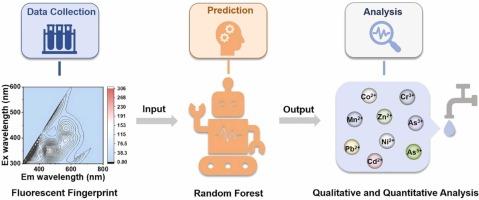Machine learning-assisted three-dimensional fluorescence for heavy metal multi-sensing
IF 8
1区 化学
Q1 CHEMISTRY, ANALYTICAL
引用次数: 0
Abstract
Heavy metal pollution is pervasive, complex, and diverse, causing lasting and potentially toxic effects on human health. Therefore, it is necessary to develop high-throughput detection of heavy metals. In this work, we proposed a machine learning-based three-dimensional fluorescent sensor strategy for effective detection of heavy metal pollution. Specifically, a multi-emitting fluorescent "chemical nose/tongue" sensor was first constructed with two different colored CDs and 5,10,15,20-tetrakis(4-trimethylamino) phenyl porphyrin (TAPP) for discriminating nine heavy metals, and then the fluorescence fingerprints were obtained based on the changes in the three-dimensional fluorescence spectra influenced by various heavy metals. The results demonstrated that the sensor easily and rapidly discriminated the categories and concentrations of multiple single heavy metal ions and binary mixed heavy metal ions within the concentration range of 10 μM–0.5 mM. Subsequently, the data input way was optimized, and the results showed that the accuracy of image recognition in predicting categories and concentrations of heavy metal ions was 75.1% and 64.4%, and the accuracy of data recognition was 97.8% and 100%. After optimizing the learning model, the Random Forest (RF) model can predict the categories and concentrations of a binary heavy metal mixture with accuracies of 100% and 91.8%, respectively. In addition, machine learning-assisted fluorescent sensors showed promising applications in real tap water and river samples. In conclusion, compared to previous analysis methods, this approach achieved qualitative and quantitative analysis of heavy metals in complex environments through three-dimensional fluorescence spectra combined with the ML strategy. Notably, the sensor did not involve cumbersome synthesis of multiple sensing channels, making it easy to construct and cost-effective.

求助全文
约1分钟内获得全文
求助全文
来源期刊

Sensors and Actuators B: Chemical
工程技术-电化学
CiteScore
14.60
自引率
11.90%
发文量
1776
审稿时长
3.2 months
期刊介绍:
Sensors & Actuators, B: Chemical is an international journal focused on the research and development of chemical transducers. It covers chemical sensors and biosensors, chemical actuators, and analytical microsystems. The journal is interdisciplinary, aiming to publish original works showcasing substantial advancements beyond the current state of the art in these fields, with practical applicability to solving meaningful analytical problems. Review articles are accepted by invitation from an Editor of the journal.
 求助内容:
求助内容: 应助结果提醒方式:
应助结果提醒方式:


